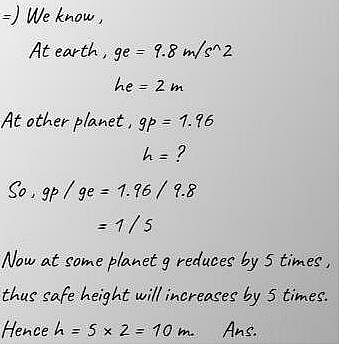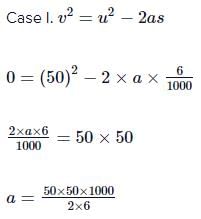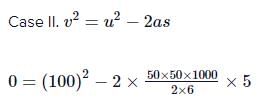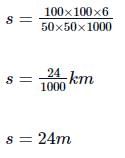All questions of Motion with Constant Acceleration for Grade 9 Exam
If the signs of the velocity and acceleration of a particle are the same, the speed of the particle ______________.- a)Remains same
- b)Increases
- c)Decreases
- d)Cannot conclude anything
Correct answer is option 'B'. Can you explain this answer?
If the signs of the velocity and acceleration of a particle are the same, the speed of the particle ______________.
a)
Remains same
b)
Increases
c)
Decreases
d)
Cannot conclude anything
|
|
Pooja Shah answered |
In this question, it has been asked about the signs of velocity and acceleration not about the values of velocity and acceleration.
So, if both the entities have same the signs, then the speed of the object will increase.
If it is accelerating in the positive direction, the negative velocity is decreasing, and the object is slowing down.
On acceleration-time graph, a horizontal line indicates:- a)zero displacement
- b)zero acceleration
- c)constant velocity
- d)constant acceleration
Correct answer is option 'D'. Can you explain this answer?
On acceleration-time graph, a horizontal line indicates:
a)
zero displacement
b)
zero acceleration
c)
constant velocity
d)
constant acceleration
|
|
Anjana Sharma answered |
A horizontal line on a acceleration- time graph indicates that object has constant acceleration.
The dimensions of (change in velocity / time) is- a)[LT-2]
- b)[LT-1]
- c)[L/T-1]
- d)[L/T-2]
Correct answer is option 'A'. Can you explain this answer?
The dimensions of (change in velocity / time) is
a)
[LT-2]
b)
[LT-1]
c)
[L/T-1]
d)
[L/T-2]
|
|
Naina Sharma answered |
We know that change in velocity / time is acceleration.
And dimension of acceleration is LT-2
A boy throws up a ball in a stationary lift and the ball returns to his hands in 10 s. Now if the lift starts moving up at a speed of 5 m/s. The time taken for a ball thrown straight up to return to his hands is:- a)more than 10 s
- b)Less than 10 s
- c)insufficient information given
- d)equal to 10 s
Correct answer is option 'D'. Can you explain this answer?
A boy throws up a ball in a stationary lift and the ball returns to his hands in 10 s. Now if the lift starts moving up at a speed of 5 m/s. The time taken for a ball thrown straight up to return to his hands is:
a)
more than 10 s
b)
Less than 10 s
c)
insufficient information given
d)
equal to 10 s
|
|
Suresh Iyer answered |
Lift moving with Uniform speed = 5m / s
Ball is thrown inside the lift
The uniform velocity of the lift does not affect the relative velocity of the ball with respect to the boy.
Relative velocity of ball = 49m/s
⇒ Relative acceleration = 9.8
Thus, u(relative) = velocity of bell
t = 2ur / gr
= (2 × 49) / 9.8
⇒ t = 10s
so, the ball will still return in 10 secs
The dimensions of instantaneous acceleration is:- a)[ LT-2]
- b)[L/T2]
- c)[L/T-1]
- d)[LT-1]
Correct answer is option 'A'. Can you explain this answer?
The dimensions of instantaneous acceleration is:
a)
[ LT-2]
b)
[L/T2]
c)
[L/T-1]
d)
[LT-1]
|
|
Neha Joshi answered |
Instantaneous acceleration is rate of change of instantaneous velocity with time or velocity upon total time, hence we get its dimension is same as of acceleration i.e. LT-2
What does this graph indicate about the motion of an object?
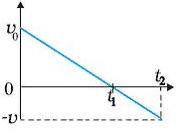
- a)Object is moving in positive direction with positive acceleration
- b)Object is moving in negative direction with negative acceleration
- c)An object is moving in positive direction till time t1, and then turns back with the same Velocity
- d)Object is moving in positive direction with negative acceleration
Correct answer is option 'D'. Can you explain this answer?
What does this graph indicate about the motion of an object?
a)
Object is moving in positive direction with positive acceleration
b)
Object is moving in negative direction with negative acceleration
c)
An object is moving in positive direction till time t1, and then turns back with the same Velocity
d)
Object is moving in positive direction with negative acceleration

|
Top Rankers answered |
Through the given graph we get that:
Velocity is decreasing from a positive constant to some negative number with zero at t1
Velocity is decreasing from a positive constant to some negative number with zero at t1
Distance from the original point increases from zero to t1 and then it decreases afterwards.
The object is moving in a positive direction at first and after time t1 it moves in a negative direction.
What does this graph indicate about the motion of an object ?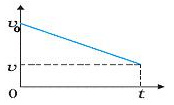
- a)object is moving in negative direction with positive acceleration
- b)object is moving in negative direction with negative acceleration
- c)object is moving in positive direction with negative acceleration
- d)object is moving in positive direction with positive acceleration
Correct answer is option 'C'. Can you explain this answer?
What does this graph indicate about the motion of an object ?
a)
object is moving in negative direction with positive acceleration
b)
object is moving in negative direction with negative acceleration
c)
object is moving in positive direction with negative acceleration
d)
object is moving in positive direction with positive acceleration
|
|
Raghav Bansal answered |
Velocity is decreasing so, acceleration is negative. Velocity is positive so direction is positive.
Hence option (C) is correct.
The position x of a particle varies with time (t) as x = 3t2 – 2t3 .The acceleration of the particle will be zero at time- a)1
- b)3/2
- c)0
- d)1/2
Correct answer is option 'D'. Can you explain this answer?
The position x of a particle varies with time (t) as x = 3t2 – 2t3 .The acceleration of the particle will be zero at time
a)
1
b)
3/2
c)
0
d)
1/2
|
|
Lavanya Menon answered |
We know that acceleration is the second derivative of change in displacement wrt time, hence we get a = 6 - 12t
When a = 0 = 6 -12t ;
We get t = ½
When a = 0 = 6 -12t ;
We get t = ½
The displacement of a particle along x-axis is given by x = 4 + 6t + 5t2. Its acceleration at t = 2s- a)2 m/s2
- b)10 m/s2
- c)1000 m/s2
- d)100 m/s2
Correct answer is option 'B'. Can you explain this answer?
The displacement of a particle along x-axis is given by x = 4 + 6t + 5t2. Its acceleration at t = 2s
a)
2 m/s2
b)
10 m/s2
c)
1000 m/s2
d)
100 m/s2
|
|
Mira Sharma answered |
usingdifferentiation
x = 18t + 5t^2
dx/dt = 18 + 10t
v = 18 + 10t
at t = 2s
v = 18 + 10x2
= 18 + 20 =38m/s
at t = 3s
v = 18 + 10x3
= 18 + 20 = 48m/s
vav= 38+48/2= 43m/s
dv/dt = 10
a = 10
a =10m/s^2
On acceleration-time graph the area under the curve equals the:- a)Meaningless
- b)Change in velocity
- c)Displacement
- d)Change in acceleration
Correct answer is option 'B'. Can you explain this answer?
On acceleration-time graph the area under the curve equals the:
a)
Meaningless
b)
Change in velocity
c)
Displacement
d)
Change in acceleration
|
|
Nandini Patel answered |
The area under an acceleration graph represents the change in velocity. In other words, the area under the acceleration graph for a certain time interval is equal to the change in velocity during that time interval.
The distances covered by a freely falling body in its first, second, third,..., nth seconds of its motion- a)forms an arithematic progression
- b)forms a geometric progression
- c)do not form any well defined series
- d)form a series corresponding to the difference of square root of the successive natural numbers.
Correct answer is option 'A'. Can you explain this answer?
The distances covered by a freely falling body in its first, second, third,..., nth seconds of its motion
a)
forms an arithematic progression
b)
forms a geometric progression
c)
do not form any well defined series
d)
form a series corresponding to the difference of square root of the successive natural numbers.
|
|
Mira Joshi answered |
Distance travelled by a body in nth second is

Here, u = 0, a = g
∴ Distance travelled by the body in 1st second is

Distance travelled by the body in 2nd second is

Distance travelled by the body in 3rd second is

and so on.
Hence, the distance covered by a freely falling body in its first, second, third ..... nth second of its motion forms an arithmetic progression.

Here, u = 0, a = g
∴ Distance travelled by the body in 1st second is

Distance travelled by the body in 2nd second is

Distance travelled by the body in 3rd second is

and so on.
Hence, the distance covered by a freely falling body in its first, second, third ..... nth second of its motion forms an arithmetic progression.
A player throws a ball upwards with an initial speed of 30 m s−1. How long does the ball take to return to the player's hands? (Take g = 10 m s−2).- a)3 s
- b)6 s
- c)9 s
- d)12 s
Correct answer is option 'B'. Can you explain this answer?
A player throws a ball upwards with an initial speed of 30 m s−1. How long does the ball take to return to the player's hands? (Take g = 10 m s−2).
a)
3 s
b)
6 s
c)
9 s
d)
12 s

|
Shubham Mogre answered |
In upward journey ball takes 3 sec and in downward journey 3 sec total 6 sec
by 1 equation of motion
v=u +at, here v=0 and u=30, a =10 solve through this .....
by 1 equation of motion
v=u +at, here v=0 and u=30, a =10 solve through this .....
A particle is released from rest from a tower of height 3h. The ratio of the intervals of time to cover three equal heights h is- a)t1:t2:t3 = 3:2:1
- b)t1:t2:t3 = 1:(√2-1):(√3-2)
- c)t1:t2:t3 = √3:√2:1
- d)t1:t2:t3 = 1:(√2-1):(√3-√2)
Correct answer is option 'D'. Can you explain this answer?
A particle is released from rest from a tower of height 3h. The ratio of the intervals of time to cover three equal heights h is
a)
t1:t2:t3 = 3:2:1
b)
t1:t2:t3 = 1:(√2-1):(√3-2)
c)
t1:t2:t3 = √3:√2:1
d)
t1:t2:t3 = 1:(√2-1):(√3-√2)
|
|
Mira Joshi answered |
Let t1, t2, t3 be the timings for three successive equal heights h covered during the free fall of the particle. Then


Subtracting (i) from (ii), we get

From (i),(iv) and (v), we get
t1:t2:t3 = 1:(√2-1) : (√3-√2)
A girl standing on a stationary lift (open from above) throws a ball upwards with initial speed 50 m s-1. The time taken by the ball to return to her hands is (Take g = 10 ms-2)- a)5s
- b)10 s
- c)15 s
- d)20 S
Correct answer is option 'B'. Can you explain this answer?
A girl standing on a stationary lift (open from above) throws a ball upwards with initial speed 50 m s-1. The time taken by the ball to return to her hands is (Take g = 10 ms-2)
a)
5s
b)
10 s
c)
15 s
d)
20 S
|
|
Jaspreet answered |
Since the ball reaches back so distance will be zero :. s =0
using second equation of motion
s=ut +1/2 at²
0= 50×t + 1/2 (-10t²)
0= 50t -5t²
50 t = 5t²
50 = 5t
t = 10 sec :)
using second equation of motion
s=ut +1/2 at²
0= 50×t + 1/2 (-10t²)
0= 50t -5t²
50 t = 5t²
50 = 5t
t = 10 sec :)
A ball is thrown vertically upwards. The acceleration due to gravity:- a)is in the upward direction
- b)is in the downward direction
- c)is in the horizontal direction
- d)always in the direction of motion
Correct answer is option 'B'. Can you explain this answer?
A ball is thrown vertically upwards. The acceleration due to gravity:
a)
is in the upward direction
b)
is in the downward direction
c)
is in the horizontal direction
d)
always in the direction of motion
|
|
Gaurav Kumar answered |
A ball is thrown vertically upwards. The acceleration due to gravity is in the downward direction.
The value of acceleration due to gravity on earth is.- a)9.8ms−2.
- b)15376
- c)227004
- d)127008
Correct answer is option 'A'. Can you explain this answer?
The value of acceleration due to gravity on earth is.
a)
9.8ms−2.
b)
15376
c)
227004
d)
127008
|
|
Ishan Ghosh answered |
Understanding Acceleration Due to Gravity
The acceleration due to gravity (g) is a fundamental constant that defines the acceleration experienced by an object when it is in free fall near the Earth's surface.
Value of g
- The standard value of acceleration due to gravity on Earth is approximately 9.8 m/s².
- This means that, neglecting air resistance, an object will increase its velocity by 9.8 meters per second for every second it is falling.
Why g is Approximately 9.8 m/s²
- Earth's Mass and Radius: The value of g is influenced by the mass of the Earth and its radius. The more massive the Earth, the stronger the gravitational pull. Similarly, the closer you are to the Earth's center (i.e., the smaller the radius), the stronger the gravitational force.
- Universal Law of Gravitation: According to this law, every mass attracts every other mass. The force of gravity is directly proportional to the product of their masses and inversely proportional to the square of the distance between their centers.
Variations of g
- It's important to note that the value of g can vary slightly depending on where you are on Earth, due to factors such as altitude and the Earth's rotation. For instance, g is slightly less at the equator compared to the poles.
Conclusion
- Among the options provided, 9.8 m/s² is the only correct and scientifically accepted value for the acceleration due to gravity on Earth, making option 'A' the right choice. Other values like 15376, 227004, and 127008 are incorrect and do not represent the gravitational acceleration experienced on our planet.
The acceleration due to gravity (g) is a fundamental constant that defines the acceleration experienced by an object when it is in free fall near the Earth's surface.
Value of g
- The standard value of acceleration due to gravity on Earth is approximately 9.8 m/s².
- This means that, neglecting air resistance, an object will increase its velocity by 9.8 meters per second for every second it is falling.
Why g is Approximately 9.8 m/s²
- Earth's Mass and Radius: The value of g is influenced by the mass of the Earth and its radius. The more massive the Earth, the stronger the gravitational pull. Similarly, the closer you are to the Earth's center (i.e., the smaller the radius), the stronger the gravitational force.
- Universal Law of Gravitation: According to this law, every mass attracts every other mass. The force of gravity is directly proportional to the product of their masses and inversely proportional to the square of the distance between their centers.
Variations of g
- It's important to note that the value of g can vary slightly depending on where you are on Earth, due to factors such as altitude and the Earth's rotation. For instance, g is slightly less at the equator compared to the poles.
Conclusion
- Among the options provided, 9.8 m/s² is the only correct and scientifically accepted value for the acceleration due to gravity on Earth, making option 'A' the right choice. Other values like 15376, 227004, and 127008 are incorrect and do not represent the gravitational acceleration experienced on our planet.
Stopping distance of a moving vehicle is directly proportional to- a)square of the initial velocity
- b)square of the initial acceleration
- c)the initial velocity
- d)the initial acceleration
Correct answer is option 'A'. Can you explain this answer?
Stopping distance of a moving vehicle is directly proportional to
a)
square of the initial velocity
b)
square of the initial acceleration
c)
the initial velocity
d)
the initial acceleration
|
|
Geetika Shah answered |
Let ds is the distance travelled by the vehicle before it stops.
Here, final velocity v = 0, initial velocity = u, S = ds
Using equation of motion
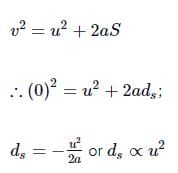
A man is standing on top of a building 100 m high. He throws two balls vertically, one at t = 0 and other after a time interval (less than 2 s). The later ball is thrown at a velocity of half the first. The vertical gap between first and second ball is 15 m at t = 2 s. The gap is found to remain constant. The velocities with which the balls were thrown are (Take g = 10 m s−2).- a)20ms−1, 10ms−1
- b)10ms−1, 5ms−1
- c)16ms−1, 8ms−1
- d)30ms−1, 15ms−1
Correct answer is option 'A'. Can you explain this answer?
A man is standing on top of a building 100 m high. He throws two balls vertically, one at t = 0 and other after a time interval (less than 2 s). The later ball is thrown at a velocity of half the first. The vertical gap between first and second ball is 15 m at t = 2 s. The gap is found to remain constant. The velocities with which the balls were thrown are (Take g = 10 m s−2).
a)
20ms−1, 10ms−1
b)
10ms−1, 5ms−1
c)
16ms−1, 8ms−1
d)
30ms−1, 15ms−1
|
|
Geetika Shah answered |
For first stone,
taking the vertical upwards motion of the first stone up to highest point
Here, u = u1, v = 0 (At highest point velocity is zero)
a = -g, S = h1
As v2 − u2 = 2aS

For second stone,
Taking the vertical upwards motion of the second stone up to highest point
here, u = U2, v = 0, a = −g, S = h2
As v2 − u2 = 2as
taking the vertical upwards motion of the first stone up to highest point
Here, u = u1, v = 0 (At highest point velocity is zero)
a = -g, S = h1
As v2 − u2 = 2aS

For second stone,
Taking the vertical upwards motion of the second stone up to highest point
here, u = U2, v = 0, a = −g, S = h2
As v2 − u2 = 2as

As per question

Subtract (ii) from (i), we get,

On substituting the given information, we get

or u1 = 20ms−1 and u2 = U1/2 = 10ms-1

A ball is thrown vertically upwards with a velocity of 20 m s-1 from the top of a multistorey building of 25 m high. the time taken by the ball to reach the ground is- a)2 s
- b)3 s
- c)5 s
- d)7 s
Correct answer is option 'C'. Can you explain this answer?
A ball is thrown vertically upwards with a velocity of 20 m s-1 from the top of a multistorey building of 25 m high. the time taken by the ball to reach the ground is
a)
2 s
b)
3 s
c)
5 s
d)
7 s
|
|
Anjali Sharma answered |
Let t1 be the time taken by the ball to reach the highest point.
here, v = 0, u = 20ms−1, a = −g = −10ms−2, t = t1
As v = u + at
∴ 0 = 20 + (−10)t1 or t1 = 2s
Taking vertical downward motion of the ball from the highest point to ground.
Here, u = 0, a = +g = 10ms−2, S = 20 m + 25 m = 45 m, t = t2
here, v = 0, u = 20ms−1, a = −g = −10ms−2, t = t1
As v = u + at
∴ 0 = 20 + (−10)t1 or t1 = 2s
Taking vertical downward motion of the ball from the highest point to ground.
Here, u = 0, a = +g = 10ms−2, S = 20 m + 25 m = 45 m, t = t2

Total time taken by the ball to reach the ground = t1 + t2 = 2s + 3s = 5s
A body falling freely under gravity passes two points 30 m apart in 1 s. From what point above the upper point it began to fall? (Take g = 9.8 ms2).- a)32.1 m
- b)16.0 m
- c)8.6 m
- d)4.0 m
Correct answer is option 'A'. Can you explain this answer?
A body falling freely under gravity passes two points 30 m apart in 1 s. From what point above the upper point it began to fall? (Take g = 9.8 ms2).
a)
32.1 m
b)
16.0 m
c)
8.6 m
d)
4.0 m
|
|
Anjali Sharma answered |
Suppose the body passes the upper point at t second and lower point at (t + 1) s, then
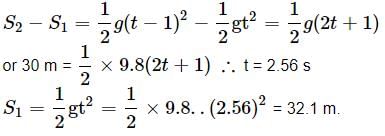
A bullet fired into a fixed wooden block loses half of its velocity after penetrating 40cm. It comes to rest after penetrating a further distance of- a)22/3 cm
- b)40/3 cm
- c)20/3 cm
- d)22/5 cm
Correct answer is option 'B'. Can you explain this answer?
A bullet fired into a fixed wooden block loses half of its velocity after penetrating 40cm. It comes to rest after penetrating a further distance of
a)
22/3 cm
b)
40/3 cm
c)
20/3 cm
d)
22/5 cm
|
|
Mira Joshi answered |
For first part of penetration, by equation of motion

For later part of penetration
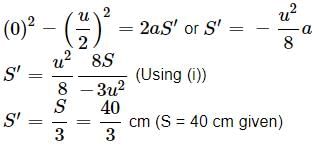
A motorcycle and a car start from rest from the same place at the same time and travel in the same direction. The motorcycle accelerates at 1.0ms−1 up to a speed of 36 kmh-1 and the car at 0.5 ms1 up to a speed of 54 kmh-1. The time at which the car would overtake the motorcycle is- a)20 s
- b)25 s
- c)30 s
- d)35 s
Correct answer is option 'D'. Can you explain this answer?
A motorcycle and a car start from rest from the same place at the same time and travel in the same direction. The motorcycle accelerates at 1.0ms−1 up to a speed of 36 kmh-1 and the car at 0.5 ms1 up to a speed of 54 kmh-1. The time at which the car would overtake the motorcycle is
a)
20 s
b)
25 s
c)
30 s
d)
35 s
|
|
Anjali Sharma answered |
When car overtakes motorcycle, both have travelled the same distance in the same time. Let the total distance travelled be S and the total time taken to overtake be t.
For motorcycle:
Maximum speed attained = 36kmh−1

Since its acceleration = 1.0ms−2, the time t1 taken by it to attain the maximum speed is given by
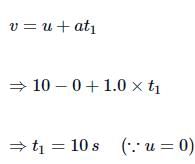
The distance covered by motorcycle in attaining the maximum speed is

The time during which the motorcycle moves with maximum speed is (t − 10)s.
The distance covered by the motorcycle during this time is

∴ Total distance travelled by motorcycle in time t is

For car:
Maximum speed attained =

Since its acceleration = 0.5ms−2
Maximum speed attained = 36kmh−1

Since its acceleration = 1.0ms−2, the time t1 taken by it to attain the maximum speed is given by

The distance covered by motorcycle in attaining the maximum speed is

The time during which the motorcycle moves with maximum speed is (t − 10)s.
The distance covered by the motorcycle during this time is

∴ Total distance travelled by motorcycle in time t is

For car:
Maximum speed attained =

Since its acceleration = 0.5ms−2
The time taken by it to attain the maximum speed is given by
15 = 0 + 0.5 x t2 or t2 = 30s (∵ u = 0)
The distance covered by the car in attaining the maximum speed is

The time during which the car moves with maximum speed is (t − 30)s.
The distance covered by the car during this time is

∴ Total distance travelled by car in time t is

From equations (i) and (ii), we get
10t − 50 = 151 − 225 or 51 = 175 or 1 = 35s
15 = 0 + 0.5 x t2 or t2 = 30s (∵ u = 0)
The distance covered by the car in attaining the maximum speed is

The time during which the car moves with maximum speed is (t − 30)s.
The distance covered by the car during this time is

∴ Total distance travelled by car in time t is

From equations (i) and (ii), we get
10t − 50 = 151 − 225 or 51 = 175 or 1 = 35s
A body sliding on a smooth inclined plane requires 4 seconds to reach the bottom starting from rest at the top. How much time does it take to cover one-fourth distance starting from rest at the top
- a)1 s
- b)4 s
- c)2s
- d)16 s
Correct answer is option 'C'. Can you explain this answer?
A body sliding on a smooth inclined plane requires 4 seconds to reach the bottom starting from rest at the top. How much time does it take to cover one-fourth distance starting from rest at the top
a)
1 s
b)
4 s
c)
2s
d)
16 s
|
|
Anjali Sharma answered |

Free fall of an object in vacuum is a case of motion with- a)uniform velocity
- b)uniform acceleration
- c)variable acceleration
- d)uniform speed
Correct answer is option 'B'. Can you explain this answer?
Free fall of an object in vacuum is a case of motion with
a)
uniform velocity
b)
uniform acceleration
c)
variable acceleration
d)
uniform speed
|
|
Ajay Yadav answered |
Free fall of an object in vacuum is a case of motion with uniform acceleration.
The earth's gravitational force at someplace in space causes an acceleration of 7m/s2 in a 1kg mass.What will be the acceleration of a 5kg mass at the same place?- a)7m/s2
- b)35m/s2
- c)1.4m/s2
- d)3.5m/s2
Correct answer is option 'A'. Can you explain this answer?
The earth's gravitational force at someplace in space causes an acceleration of 7m/s2 in a 1kg mass.What will be the acceleration of a 5kg mass at the same place?
a)
7m/s2
b)
35m/s2
c)
1.4m/s2
d)
3.5m/s2
|
|
Hansa Sharma answered |
The acceleration due to gravity does not vary with the change in the mass of the object as it is a dimensionless quantity representing the amount of matter in a particle or object.
Therefore, the acceleration of a 5 kg mass at the same place is 7m/s2.
Therefore, the acceleration of a 5 kg mass at the same place is 7m/s2.
A body A starts from rest with an acceleration a1. After 2 seconds, another body B starts from rest with an acceleration a2. If they travel equal distances in the 5th second, after the start of A, then the ratio a1 : a2, is equal to- a)5 : 9
- b)5 : 7
- c)9 : 5
- d)9 : 7
Correct answer is option 'A'. Can you explain this answer?
A body A starts from rest with an acceleration a1. After 2 seconds, another body B starts from rest with an acceleration a2. If they travel equal distances in the 5th second, after the start of A, then the ratio a1 : a2, is equal to
a)
5 : 9
b)
5 : 7
c)
9 : 5
d)
9 : 7
|
|
Gaurav Kumar answered |
Time taken by body A, t1 = 5s
Acceleration of body A = a1
Time taken by body B, t2 = 5 − 2 = 3s
Acceleration of body B = a2
Distance covered by first body in 5th second after its start,

Distance covered by the second body in the 3rd second after its start,

Since S5 = S3

Which of the following statements is not correct?- a)The zero velocity of a body at any instant does not necessarily impy zero acceleration at that instant.
- b)The kinematic equation of motions are true only for motion in which the magnitude and the direction of acceleration are constants during the couse of motion.
- c)The sign of acceleration tells us whether the particle's speed is increasing or decreasing.
- d)All of these.
Correct answer is option 'C'. Can you explain this answer?
Which of the following statements is not correct?
a)
The zero velocity of a body at any instant does not necessarily impy zero acceleration at that instant.
b)
The kinematic equation of motions are true only for motion in which the magnitude and the direction of acceleration are constants during the couse of motion.
c)
The sign of acceleration tells us whether the particle's speed is increasing or decreasing.
d)
All of these.
|
|
Aashna Rane answered |
Explanation:
The correct answer is option 'C' - The sign of acceleration tells us whether the particle's speed is increasing or decreasing.
Reason:
The sign of acceleration does not directly tell us whether the particle's speed is increasing or decreasing. The sign of acceleration only indicates the direction of the acceleration vector, not its magnitude.
Example:
Consider a particle moving in a straight line. If the particle is moving in the positive direction and has a positive acceleration, it means that the particle is speeding up. However, if the particle is moving in the positive direction and has a negative acceleration, it means that the particle is slowing down. Similarly, if the particle is moving in the negative direction and has a positive acceleration, it means that the particle is slowing down, while a negative acceleration means that the particle is speeding up.
Key Points:
- The sign of acceleration indicates the direction of the acceleration vector, not whether the particle's speed is increasing or decreasing.
- The magnitude of acceleration determines the rate of change of velocity, which indirectly affects the particle's speed. If the magnitude of acceleration is positive, the particle's speed may increase, while a negative magnitude of acceleration may cause the particle's speed to decrease.
- To determine whether the particle's speed is increasing or decreasing, one needs to consider the sign and magnitude of both velocity and acceleration vectors.
Conclusion:
The statement that the sign of acceleration tells us whether the particle's speed is increasing or decreasing is not correct. The sign of acceleration only indicates the direction of the acceleration vector, while the magnitude of acceleration determines the rate of change of velocity, which indirectly affects the particle's speed.
The correct answer is option 'C' - The sign of acceleration tells us whether the particle's speed is increasing or decreasing.
Reason:
The sign of acceleration does not directly tell us whether the particle's speed is increasing or decreasing. The sign of acceleration only indicates the direction of the acceleration vector, not its magnitude.
Example:
Consider a particle moving in a straight line. If the particle is moving in the positive direction and has a positive acceleration, it means that the particle is speeding up. However, if the particle is moving in the positive direction and has a negative acceleration, it means that the particle is slowing down. Similarly, if the particle is moving in the negative direction and has a positive acceleration, it means that the particle is slowing down, while a negative acceleration means that the particle is speeding up.
Key Points:
- The sign of acceleration indicates the direction of the acceleration vector, not whether the particle's speed is increasing or decreasing.
- The magnitude of acceleration determines the rate of change of velocity, which indirectly affects the particle's speed. If the magnitude of acceleration is positive, the particle's speed may increase, while a negative magnitude of acceleration may cause the particle's speed to decrease.
- To determine whether the particle's speed is increasing or decreasing, one needs to consider the sign and magnitude of both velocity and acceleration vectors.
Conclusion:
The statement that the sign of acceleration tells us whether the particle's speed is increasing or decreasing is not correct. The sign of acceleration only indicates the direction of the acceleration vector, while the magnitude of acceleration determines the rate of change of velocity, which indirectly affects the particle's speed.
A body initially at rest is moving with uniform acceleration a. Its velocity after n seconds is v. The displacement of the body in last 2 s is- a)

- b)

- c)

- d)

Correct answer is option 'A'. Can you explain this answer?
A body initially at rest is moving with uniform acceleration a. Its velocity after n seconds is v. The displacement of the body in last 2 s is
a)

b)

c)

d)

|
|
Pooja Shah answered |
Displacement in last 2 second

Acceleration a = v/n
(∵ t = ns)
Displacement in last 2s =


Acceleration a = v/n
(∵ t = ns)
Displacement in last 2s =

The velocity of a particle at an instant is 10 ms-1 After 3 s its velocity will becomes 16 ms-1. The velocity at 2 s, before the given instant will be- a)6 ms-1
- b)4 ms-1
- c)2 ms-1
- d)1 ms-1
Correct answer is option 'A'. Can you explain this answer?
The velocity of a particle at an instant is 10 ms-1 After 3 s its velocity will becomes 16 ms-1. The velocity at 2 s, before the given instant will be
a)
6 ms-1
b)
4 ms-1
c)
2 ms-1
d)
1 ms-1
|
|
Gaurav Kumar answered |
Here, u = 10ms−1, t = 3s, v = 16ms−1

Now velocity at 2 s, before the given instant
10 = u + 2 x 2
∴ u = 6 m s−1 (since v = u + at)
10 = u + 2 x 2
∴ u = 6 m s−1 (since v = u + at)
Two balls are dropped from the same height from places A and B. The body at B takes two seconds less to reach the ground at B strikes the ground with a velocity greater than at A by 10m/s. The product of the acceleration due to gravity at the two places A and B is:- a)5
- b)25
- c)125
- d)12.5
Correct answer is option 'B'. Can you explain this answer?
Two balls are dropped from the same height from places A and B. The body at B takes two seconds less to reach the ground at B strikes the ground with a velocity greater than at A by 10m/s. The product of the acceleration due to gravity at the two places A and B is:
a)
5
b)
25
c)
125
d)
12.5
|
|
Vivek Patel answered |
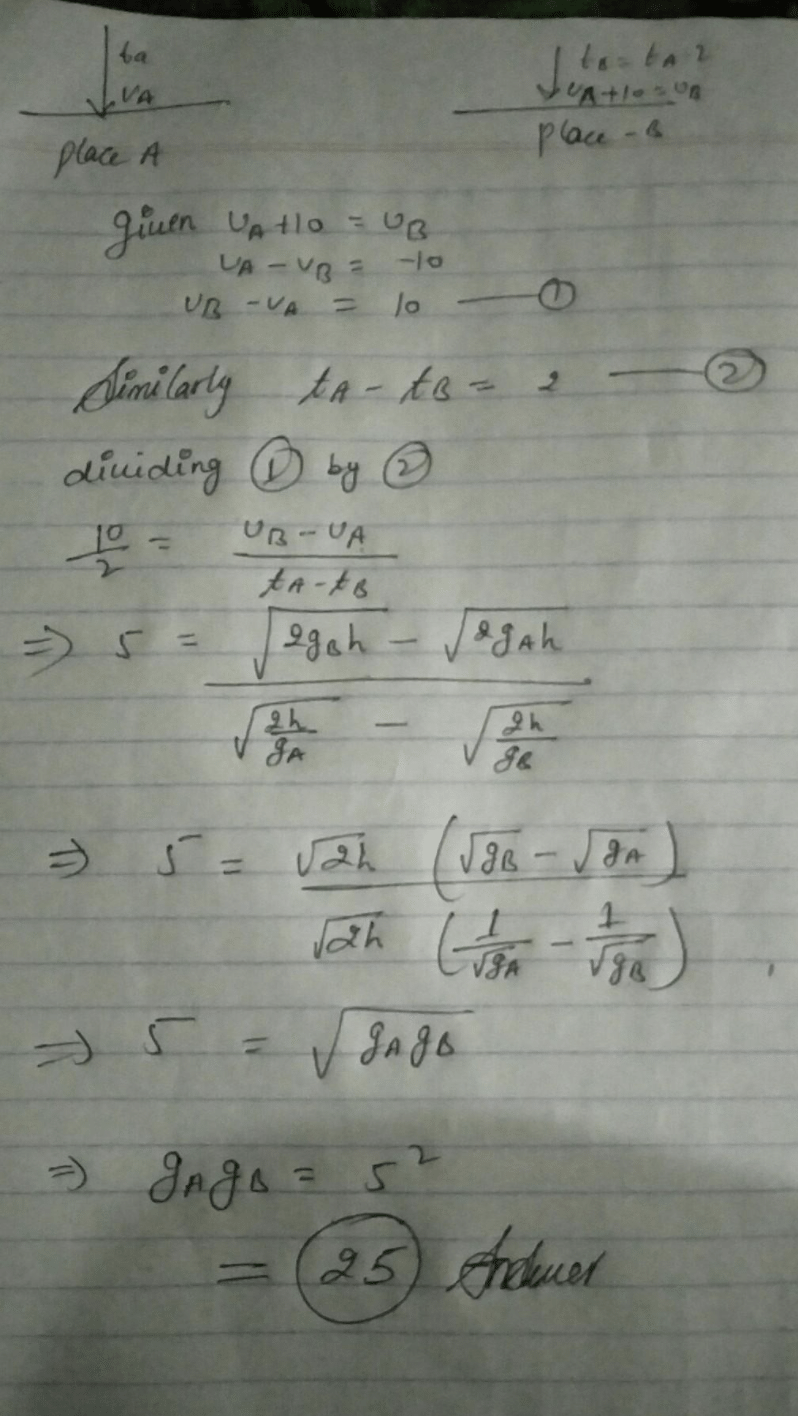
An object falling through a fluid is observed to have acceleration given by a = g − bv where g = gravitational acceleration and b is constant. After a long time of release, it is observed to fall with constant speed. The value of constant speed is- a)g/b
- b)b/g
- c)bg
- d)b
Correct answer is option 'A'. Can you explain this answer?
An object falling through a fluid is observed to have acceleration given by a = g − bv where g = gravitational acceleration and b is constant. After a long time of release, it is observed to fall with constant speed. The value of constant speed is
a)
g/b
b)
b/g
c)
bg
d)
b
|
|
Hansa Sharma answered |
Here, a = g − bv
When an object falls with constant speed vc, its acceleration becomes zero.
∴ g − bvc = 0 or vc = g/b
When an object falls with constant speed vc, its acceleration becomes zero.
∴ g − bvc = 0 or vc = g/b
Two trains A and B of length 400 m each are moving on two parallel tracks with a uniform speed of 72 km h-1 in the same direction, with A ahead of B. The driver of B decides to overtake A and accelerates by 1 ms-2. If after 50s, the guard of B just brushed past A, what was the original distance between them?- a)750 m
- b)1000 m
- c)1250 m
- d)2250 m
Correct answer is option 'C'. Can you explain this answer?
Two trains A and B of length 400 m each are moving on two parallel tracks with a uniform speed of 72 km h-1 in the same direction, with A ahead of B. The driver of B decides to overtake A and accelerates by 1 ms-2. If after 50s, the guard of B just brushed past A, what was the original distance between them?
a)
750 m
b)
1000 m
c)
1250 m
d)
2250 m
|
|
Ananya Das answered |

For train B,

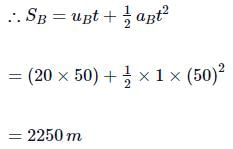
Original distance between A and B = SB − SA = 2250m − 1000m = 1250m
A body covers 20 m, 22 m, 24 m, in 8th, 9th and 10th seconds respectively. The body starts- a)from rest and moves with uniform velocity.
- b)from rest and moves with uniform acceleration.
- c)with an initial velocity and moves with uniform acceleration.
- d)with an initial velocity and moves with uniform velocity.
Correct answer is option 'C'. Can you explain this answer?
A body covers 20 m, 22 m, 24 m, in 8th, 9th and 10th seconds respectively. The body starts
a)
from rest and moves with uniform velocity.
b)
from rest and moves with uniform acceleration.
c)
with an initial velocity and moves with uniform acceleration.
d)
with an initial velocity and moves with uniform velocity.
|
|
Ananya Das answered |
As distance travelled in successive seconds differ by 2 m each, therefore acceleration is constant = 2ms−2


The diameters of two planets are in the ratio 4:1 and their mean densities in the ratio 1:2. The acceleration due to gravity on the planets will be in ratio
- a)2:1
- b)2:3
- c)1:2
- d)4:1
Correct answer is option 'A'. Can you explain this answer?
The diameters of two planets are in the ratio 4:1 and their mean densities in the ratio 1:2. The acceleration due to gravity on the planets will be in ratio
a)
2:1
b)
2:3
c)
1:2
d)
4:1
|
|
Gaurav Kumar answered |
Acceleration due to gravity is given by the equation g = GM/R2 (at surface)
so g1 = GM1 /R12 and g2 = GM2 /R22 (gravities at planets 1 and 2)
also M1/M2 = V1p1/V2p2 = R13 p1/ R23 p2 (as V = 4/3 π r3
Therefore, g1/g2 = R1 ρ1 / R2 ρ2 = (4/1) x (1/2) = 2:1
Radius of planet A is twice that of planet B and the dencity of A is one third that of B . The ratio of the acceleration due to gravity at the surface of A to that at the surface of B is.-- a)2:3
- b)3:2
- c)3:4
- d)4:3
Correct answer is option 'A'. Can you explain this answer?
Radius of planet A is twice that of planet B and the dencity of A is one third that of B . The ratio of the acceleration due to gravity at the surface of A to that at the surface of B is.-
a)
2:3
b)
3:2
c)
3:4
d)
4:3
|
|
Naina Sharma answered |
Radius of planet A is twice that of planet B and the density of A is one-third that of B.
so, the radius is

The density is
We know that,
The acceleration due to gravity
The ratio of the acceleration due to gravity at the surface of A to that at the surface of B is
We know,
Mass = density X Volume
Hence, the ratio of the acceleration due to gravity is 2:3.
Force of gravity is least at- a)The equator
- b)The poles
- c)A point in between equator and any pole
- d)None of these
Correct answer is option 'A'. Can you explain this answer?
Force of gravity is least at
a)
The equator
b)
The poles
c)
A point in between equator and any pole
d)
None of these
|
|
Bhargavi Bajaj answered |
Explanation:
Gravity is the force that attracts two bodies towards each other. The force of gravity depends on the mass of the two bodies and the distance between them. The closer the two bodies are, the stronger the force of gravity between them.
Gravity at Equator, Poles and in between:
- The Earth is not a perfect sphere, it is slightly flattened at the poles and bulging at the equator due to its rotation. This means that the distance from the center of the Earth to a point on the equator is greater than the distance from the center of the Earth to a point on the poles.
- As the force of gravity depends on the distance between two bodies, it is least at the equator where the distance from the center of the Earth is the greatest.
- At the poles, the force of gravity is the greatest as the distance from the center of the Earth is the least.
- The force of gravity at a point in between the equator and any pole would be somewhere in between the force of gravity at the equator and the force of gravity at the poles.
Conclusion:
Therefore, the correct answer is option 'A' as the force of gravity is the least at the equator due to the greater distance from the center of the Earth.
Gravity is the force that attracts two bodies towards each other. The force of gravity depends on the mass of the two bodies and the distance between them. The closer the two bodies are, the stronger the force of gravity between them.
Gravity at Equator, Poles and in between:
- The Earth is not a perfect sphere, it is slightly flattened at the poles and bulging at the equator due to its rotation. This means that the distance from the center of the Earth to a point on the equator is greater than the distance from the center of the Earth to a point on the poles.
- As the force of gravity depends on the distance between two bodies, it is least at the equator where the distance from the center of the Earth is the greatest.
- At the poles, the force of gravity is the greatest as the distance from the center of the Earth is the least.
- The force of gravity at a point in between the equator and any pole would be somewhere in between the force of gravity at the equator and the force of gravity at the poles.
Conclusion:
Therefore, the correct answer is option 'A' as the force of gravity is the least at the equator due to the greater distance from the center of the Earth.
Which of the following equations does not represent the kinematic equations of motion?- a)v = u + at
- b)S = ut + 1/2at2
- c)S = vt + 1/2at2
- d)v2 - u2 = 2aS
Correct answer is option 'C'. Can you explain this answer?
Which of the following equations does not represent the kinematic equations of motion?
a)
v = u + at
b)
S = ut + 1/2at2
c)
S = vt + 1/2at2
d)
v2 - u2 = 2aS
|
|
Mira Joshi answered |
S = vt + 1/2at2
It is not a kinematic equation of motion.
All others are three kinematic equations of motion.
It is not a kinematic equation of motion.
All others are three kinematic equations of motion.
A girl standing on a stationary lift (open from above) throws a ball upwards with initial speed 50 m s-1. if the lift starts moving up with a uniform speed of 5ms−1 and the girl again throws the ball up with the same speed, how long does the ball take to return to her hands?- a)5s
- b)10 s
- c)15 s
- d)20 S
Correct answer is option 'B'. Can you explain this answer?
A girl standing on a stationary lift (open from above) throws a ball upwards with initial speed 50 m s-1. if the lift starts moving up with a uniform speed of 5ms−1 and the girl again throws the ball up with the same speed, how long does the ball take to return to her hands?
a)
5s
b)
10 s
c)
15 s
d)
20 S
|
|
Geetika Shah answered |
When the lift starts moving upwards with uniform speed of 5 ms−1, there is no change of relative velocity of ball w.r.t. girl. Hence, even in this case the ball will return to the girl’s hands in the same time i.e 10s.
A body starts from rest and moves with constant acceleration for t s. It travels a distance x1 in first half of time and x2 in next half of time, then
- a)x2 = 3x1
- b)x2 = x1
- c)x2 = 4x1
- d)x2 = 2x1
Correct answer is option 'A'. Can you explain this answer?
A body starts from rest and moves with constant acceleration for t s. It travels a distance x1 in first half of time and x2 in next half of time, then
a)
x2 = 3x1
b)
x2 = x1
c)
x2 = 4x1
d)
x2 = 2x1
|
|
Mira Joshi answered |
As the body starts from rest,
∴ u = 0
Let a be constant acceleration of the body.
Distance travelled by the body in (t/2) s is
x1=ut + 1/2 at2
∴ u = 0
Let a be constant acceleration of the body.
Distance travelled by the body in (t/2) s is
x1=ut + 1/2 at2

Distance travelled by the body in t s is

A player throws a ball vertically upwards with velocity u. At highest point,- a)both the velocity and acceleration of the ball are zero.
- b)the velocity of the ball is u but its acceleration.
- c)the velocity of the ball is zero but its acceleration is g.
- d)the velocity of the ball is u but its acceleration is g.
Correct answer is option 'C'. Can you explain this answer?
A player throws a ball vertically upwards with velocity u. At highest point,
a)
both the velocity and acceleration of the ball are zero.
b)
the velocity of the ball is u but its acceleration.
c)
the velocity of the ball is zero but its acceleration is g.
d)
the velocity of the ball is u but its acceleration is g.
|
|
Raghav Bansal answered |
At the highest point velocity of the ball becomes zero, but its acceleration is equal to g.
An auto travelling along a straight road increases its speed from 30.0 m s-1 to 50.0 m s-1 in a distance of 180 m. If the acceleration is constant, how much time elapses while the auto moves this distance?- a)6.0 S
- b)4.5
- c)3.6 s
- d)7.03
Correct answer is option 'B'. Can you explain this answer?
An auto travelling along a straight road increases its speed from 30.0 m s-1 to 50.0 m s-1 in a distance of 180 m. If the acceleration is constant, how much time elapses while the auto moves this distance?
a)
6.0 S
b)
4.5
c)
3.6 s
d)
7.03
|
|
Suresh Iyer answered |
Let a be constant acceleration of auto.
Here, u = 30ms−1, v = 50ms−1, S = 180 m
As v2 − u2 = 2aS
Here, u = 30ms−1, v = 50ms−1, S = 180 m
As v2 − u2 = 2aS

Solving this quadratic equation by quadratic formula, we get = 4.5s, −18 s, (t can't be negative)
∴ t = 4.5 s
It is a common observation that rain clouds can be at about 1 km altitude above the ground. If a rain drop falls from such a height freely under gravity, then what will be its speed in km h-1 (Take g = 10 m )- a)510
- b)610
- c)710
- d)910
Correct answer is option 'A'. Can you explain this answer?
It is a common observation that rain clouds can be at about 1 km altitude above the ground. If a rain drop falls from such a height freely under gravity, then what will be its speed in km h-1 (Take g = 10 m )
a)
510
b)
610
c)
710
d)
910
|
|
Manisha Bajaj answered |
Given:
- Height of rain clouds above the ground = 1 km = 1000 m
- Acceleration due to gravity (g) = 10 m/s²
To find:
- Speed of the raindrop in km/h
Solution:
We can solve this problem using the equations of motion.
Step 1: Finding the time taken by the raindrop to fall
Using the second equation of motion:
v = u + gt
Where,
v = final velocity (which is 0 m/s as the raindrop falls freely)
u = initial velocity (which is also 0 m/s as the raindrop starts from rest)
g = acceleration due to gravity
t = time taken
0 = 0 + (10)(t)
0 = 10t
t = 0 s
The time taken by the raindrop to fall is 0 seconds.
Step 2: Converting the height and time into the same units
Since the height of the rain clouds is given in kilometers and the time is given in seconds, we need to convert them into the same units. Let's convert the height into meters.
Height of rain clouds = 1 km = 1000 m
Step 3: Finding the final velocity
Using the first equation of motion:
v = u + gt
Where,
v = final velocity
u = initial velocity (which is 0 m/s)
g = acceleration due to gravity (10 m/s²)
t = time taken (0 s)
v = 0 + (10)(0)
v = 0 m/s
The final velocity of the raindrop is 0 m/s.
Step 4: Converting the speed into km/h
Since the final velocity is given in m/s, we need to convert it into km/h.
Speed of the raindrop = 0 m/s
Speed of the raindrop = 0 × 3.6 km/h (1 m/s = 3.6 km/h)
The speed of the raindrop is 0 km/h.
Therefore, the correct answer is option 'A' (0 km/h).
- Height of rain clouds above the ground = 1 km = 1000 m
- Acceleration due to gravity (g) = 10 m/s²
To find:
- Speed of the raindrop in km/h
Solution:
We can solve this problem using the equations of motion.
Step 1: Finding the time taken by the raindrop to fall
Using the second equation of motion:
v = u + gt
Where,
v = final velocity (which is 0 m/s as the raindrop falls freely)
u = initial velocity (which is also 0 m/s as the raindrop starts from rest)
g = acceleration due to gravity
t = time taken
0 = 0 + (10)(t)
0 = 10t
t = 0 s
The time taken by the raindrop to fall is 0 seconds.
Step 2: Converting the height and time into the same units
Since the height of the rain clouds is given in kilometers and the time is given in seconds, we need to convert them into the same units. Let's convert the height into meters.
Height of rain clouds = 1 km = 1000 m
Step 3: Finding the final velocity
Using the first equation of motion:
v = u + gt
Where,
v = final velocity
u = initial velocity (which is 0 m/s)
g = acceleration due to gravity (10 m/s²)
t = time taken (0 s)
v = 0 + (10)(0)
v = 0 m/s
The final velocity of the raindrop is 0 m/s.
Step 4: Converting the speed into km/h
Since the final velocity is given in m/s, we need to convert it into km/h.
Speed of the raindrop = 0 m/s
Speed of the raindrop = 0 × 3.6 km/h (1 m/s = 3.6 km/h)
The speed of the raindrop is 0 km/h.
Therefore, the correct answer is option 'A' (0 km/h).
A body covers a distance of 4 m in 3rd second and 12 m in 5th second. If the motion is uniformly accelerated, how far will it travel in the next 3 seconds?- a)10 m
- b)30 m
- c)40 m
- d)60 m
Correct answer is option 'D'. Can you explain this answer?
A body covers a distance of 4 m in 3rd second and 12 m in 5th second. If the motion is uniformly accelerated, how far will it travel in the next 3 seconds?
a)
10 m
b)
30 m
c)
40 m
d)
60 m
|
|
Ajay Yadav answered |

On solving, u = −6ms−1, a = 4ms−2
Distance travelled in next 3 seconds = S8 − S5

The mass of a planet is 5 times the mass of the earth but its diameter is the same as that of the earth. How much work is done in lifting a stone of mass 3 kg through a distance of 1 m on this planet?- a)100 j
- b)150 j
- c)175 j
- d)200 j
Correct answer is option 'B'. Can you explain this answer?
The mass of a planet is 5 times the mass of the earth but its diameter is the same as that of the earth. How much work is done in lifting a stone of mass 3 kg through a distance of 1 m on this planet?
a)
100 j
b)
150 j
c)
175 j
d)
200 j
|
|
Hansa Sharma answered |
We know that g∝Mp, Where Mp is mass of planet.
So, gp=5×10=50 m/s2
So work done in lifting a 3 kg stone by 1m =50×3×1=150J
The earth is an approximate sphere. If the interior contained matter which is not of the same density everywhere, then on the surface of the earth, the acceleration due to gravity :- a)will be directed towards the centre but not the same everywhere.
- b)will have the same value everywhere but not directed towards the centre.
- c)will be same everywhere in magnitude directed towards the centre.
- d)cannot be zero at at point.
Correct answer is option 'D'. Can you explain this answer?
The earth is an approximate sphere. If the interior contained matter which is not of the same density everywhere, then on the surface of the earth, the acceleration due to gravity :
a)
will be directed towards the centre but not the same everywhere.
b)
will have the same value everywhere but not directed towards the centre.
c)
will be same everywhere in magnitude directed towards the centre.
d)
cannot be zero at at point.
|
|
Raghav Bansal answered |
There's no such thing as zero gravity. Weightlessness and zero gravity are two different things. The earth's gravity keeps the moon in orbit. And astronauts are generally much closer to earth than the moon is, which means that the earth's pull on them has to be much stronger.
A stone is dropped from the top of a tall cliff and n seconds later another stone is thrown vertically downwards with a velocity u. Then the second stone overtakes the first, below the top of the cliff at a distance given by- a)

- b)

- c)

- d)

Correct answer is option 'A'. Can you explain this answer?
A stone is dropped from the top of a tall cliff and n seconds later another stone is thrown vertically downwards with a velocity u. Then the second stone overtakes the first, below the top of the cliff at a distance given by
a)

b)

c)

d)

|
|
Hansa Sharma answered |
Let the two stones meet at time t.
for the first stone,

for the first stone,

for the second stone,

Displacement is same
∴ S1 = S2

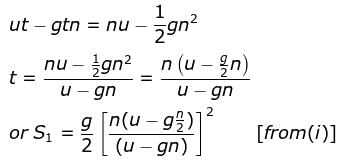
Chapter doubts & questions for Motion with Constant Acceleration - Physics 2025 is part of Grade 9 exam preparation. The chapters have been prepared according to the Grade 9 exam syllabus. The Chapter doubts & questions, notes, tests & MCQs are made for Grade 9 2025 Exam. Find important definitions, questions, notes, meanings, examples, exercises, MCQs and online tests here.
Chapter doubts & questions of Motion with Constant Acceleration - Physics in English & Hindi are available as part of Grade 9 exam.
Download more important topics, notes, lectures and mock test series for Grade 9 Exam by signing up for free.
Physics
307 videos|482 docs|202 tests
|

Contact Support
Our team is online on weekdays between 10 AM - 7 PM
Typical reply within 3 hours
|
Free Exam Preparation
at your Fingertips!
Access Free Study Material - Test Series, Structured Courses, Free Videos & Study Notes and Prepare for Your Exam With Ease

 Join the 10M+ students on EduRev
Join the 10M+ students on EduRev
|

|
Create your account for free
OR
Forgot Password
OR
Signup to see your scores
go up
within 7 days!
within 7 days!
Takes less than 10 seconds to signup

